2009 Nissan Maxima - Click above for high-res image gallery
Once upon a time, labeling anything other than a two-door, two-seater a "sports car" would have been anathema to enthusiasts. And calling a mid-size sedan by the same name would have been utterly absurd. But when Nissan originally slapped the 4DSC ("four-door sports car") label on the Maxima 20 years ago, the automotive landscape was a very different place. Today, the sports sedan has been embraced by the masses, and with a series of "four-door coupes" hitting the market, consumers looking for an entertaining ride with seating for four have a host of options to choose from.
So when Nissan trotted out the all-new 2009 Maxima in New York last year and revived the 4DSC label, the automaker's past successes weighed heavily on the redesigned sedan. Would it still deliver the power and handling of its predecessors or would it be just another poseur in a see of wannabe sports sedans? More to the point: is this really a sports car? Let's find out.
Photos Copyright ©2009 Sam Abuelsamid / Weblogs, Inc.
Nissan has always had a sporting streak running through its DNA. What began with the Datsun 240Z and 510 has evolved into 370Z, GT-R and, yes, even the Maxima. When the latest edition of the brand's flagship sedan debuted a year ago, it introduced a new design language dubbed "liquid motion." The theme was a complete departure from the sharp creases and relatively slab sides of the previous generation model, beginning with the headlights that form a stylized "L," a cue that has since been carried over to the new Z.
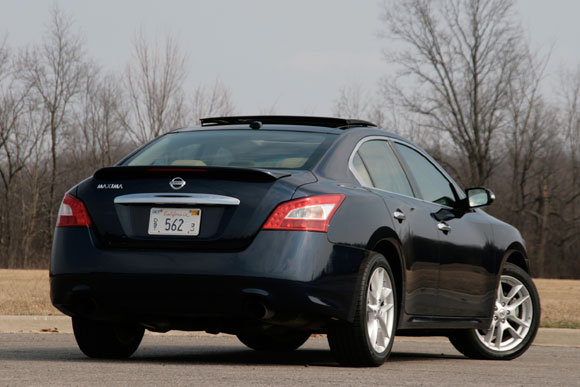
Another element of the new design theme which first appeared on Nissan's 2008 Forum minivan concept is the hood profile. A pair of ridges run from the grille ends to the A-pillars with the top crease chamfered at the edge. The ridges flank a wave that runs from end to end, providing visual interest both from the outside as well as the driver's seat. All four fenders swell outward, creating prominent shoulders rife with muscularity. The roofline has a fastback profile that contributes to the sedan's sporting character, but stays elevated long enough to ensure decent rear head-room before falling away.
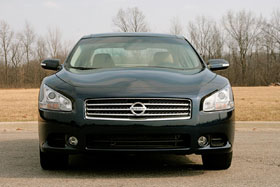
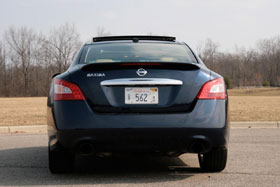
The Maxima's styling has a lot to like, but there are some questionable details. From where we sit, the weakest styling element is the front fascia and the grille housed within. From certain angles, the nose looks too low and too heavy, with alarming amounts of overhang – and the same issue carries over to the rear. In both cases, a contributing factor may be the revised proportions that come from the two-inch shorter wheelbase compared to the 2008 model, along with a four-inch shorter overall length.
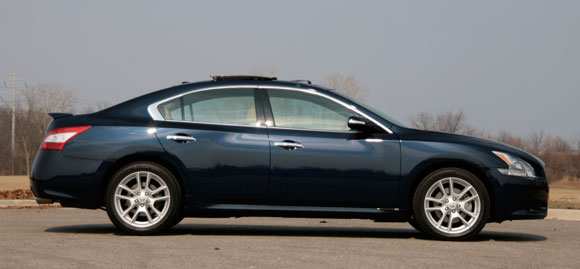
Inside, the Maxima is a curious mix of premium and cheap. The shapes and textures have attractive colors and textures, but aside from the top of the dash, the rest of the surfaces surrounding the driver are hard plastics. While most of the pieces don't deliver luxurious tactility, the matte finishes look pleasant enough and are well finished with no rough or uneven edges. Those surfaces that the driver comes into contact with most often are finished in leather, including the thick-rimmed, heated steering wheel.
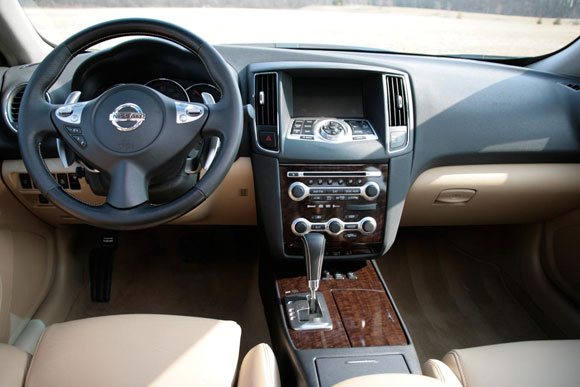
The driver's seat is another mixed bag, with eight-way power adjustability, along with a very welcome manually adjustable thigh support. Unfortunately, we had issues with getting the seat back to fit comfortably, as the upper portion felt slightly lumpy and a bit too thick. The standard rear seat features a 60/40 split seat back. However, if you opt for the $3,450 premium package fitted to our test car, the rear seating area is replaced with a set of re-contoured buckets. As such, the seat back is fixed in place with only a center pass through for long, skinny items. The premium package also includes a dual panel glass moonroof, although only the front half opens.
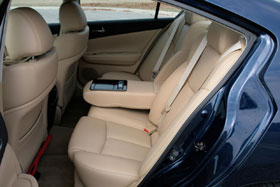
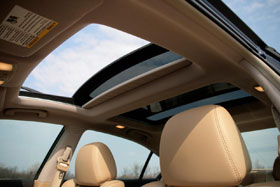
If the Maxima is supposed to be a sports car, it has to be packing a great engine. And as we'd expect from the automaker, it doesn't disappoint. As a modern Nissan, it's only fitting that the Maxima is powered by the 3.5-liter VQ V6 as used in the 350Z and numerous Infiniti models. Unlike the Z, however, the engine is mounted transversely, driving the front wheels through an updated version of Nissan's Xtronic continuously variable transmission. In a marked departure from most CVT transmissions, the programming on the Maxima's unit doesn't have the unnerving characteristic of holding the engine at a constant speed as obviously while accelerating. Instead, you get to listen to that fabulous six as the revs climb. Whether this unique arrangement ultimately takes a toll on overall fuel efficiency is a topic we'll leave open for discussion.
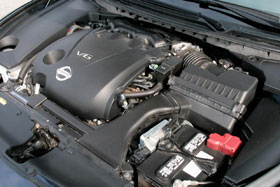
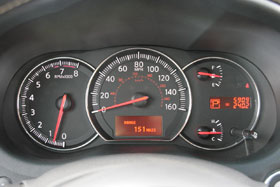
In addition to the normal "D" mode, the Maxima offers a more aggressive "Ds" as well as full "manual" option. The aforementioned premium pack includes steering wheel-mounted paddle shifters in addition to the tap shift gate on the console that allows the selection of six pre-programmed "ratios." In "Ds" mode, the transmission keeps the engine climbing towards the redline before shifting, and like most similarly equipped cars, it also downshifts while decelerating to provide engine braking.
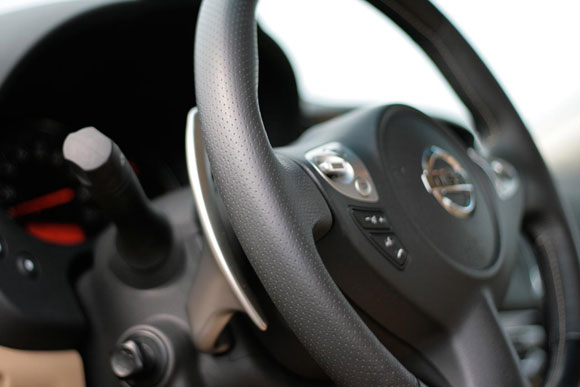
So does the Maxima drive like a sports car? It's certainly has the right engine, with 290 hp and 261 lb-ft of twist providing brisk acceleration and the run to 60 mph consistently coming up in less than six seconds. Nissan engineers have done an admirable job of configuring the front suspension to keep the Maxima from veering off into the ditch when the go pedal is pressed to the floor, and the VQ is always good for audible delights and this installation is no exception. As the revs climb, a thrilling mechanical symphony emanates from under the hood while a sharp bark – distinctly reminiscent of the Z – comes from the exhaust under hard acceleration. In normal "Drive" mode, initial throttle tip-in feels a bit lazy, but pulling the shifter back into "Ds" seems to to remedy the issue. And although you can't get a proper manual transmission in the Maxima, if you want control of the ratios, tapping the paddles or the shift lever produces quick gear changes that put you right into the powerband.
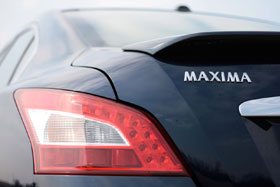
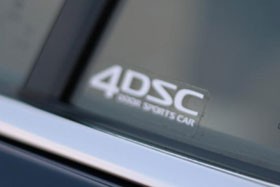
But delivering on the sports car experience is about more than just acceleration. Eventually, the time comes to change direction. The leather-wrapped tiller provides precise control over the heading with no free-play and a measured reaction to torque in proportion to cornering forces. Compared to the Acura TL, the Maxima's steering feels much more natural and fun to toss into corners, provided that the pavement remains smooth. The spring rates provide a good balance between ride quality and road holding, but the damping needs more tweaking. When the road surface gets uneven, the rebound damping comes across as weak and the Maxima can feel floaty. It's nothing that can't be easily fixed, but it's not quite right for a sports car. When the time comes to scrub off speed, the brakes feel fully up to the task, and if things begin to go pear-shaped, the stability control engages smoothly without jerking the car around.
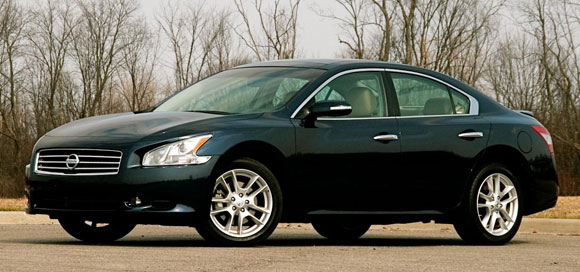
When playtime is over and a road-trip or gentle commute is in order, the Maxima is a pleasant place to be. Wind noise on the highway is nicely subdued and the XM NavTraffic system will help you avoid getting stuck in a jam. Our test car was the uplevel SV trim with a base price of $31,990, and with the premium and technology packages, the bottom line swelled to $38,535 (including delivery). When venturing into that price point, the Maxima's four-door sports car designation truly comes into question. Does it deliver? Not quite. It's a handsome sedan with a healthy dose of engagement. It's not so large and heavy that it feels ponderous, and having a VQ35 at your command is always a good thing. So... sports sedan? Yes. But this is no Z, and the 4DSC label may be going a bit too far. Now, if Nissan went back to a rear-drive Maxima that might be another story. But that car already exists. It's called the Infiniti G37.
Photos Copyright ©2009 Sam Abuelsamid / Weblogs, Inc.
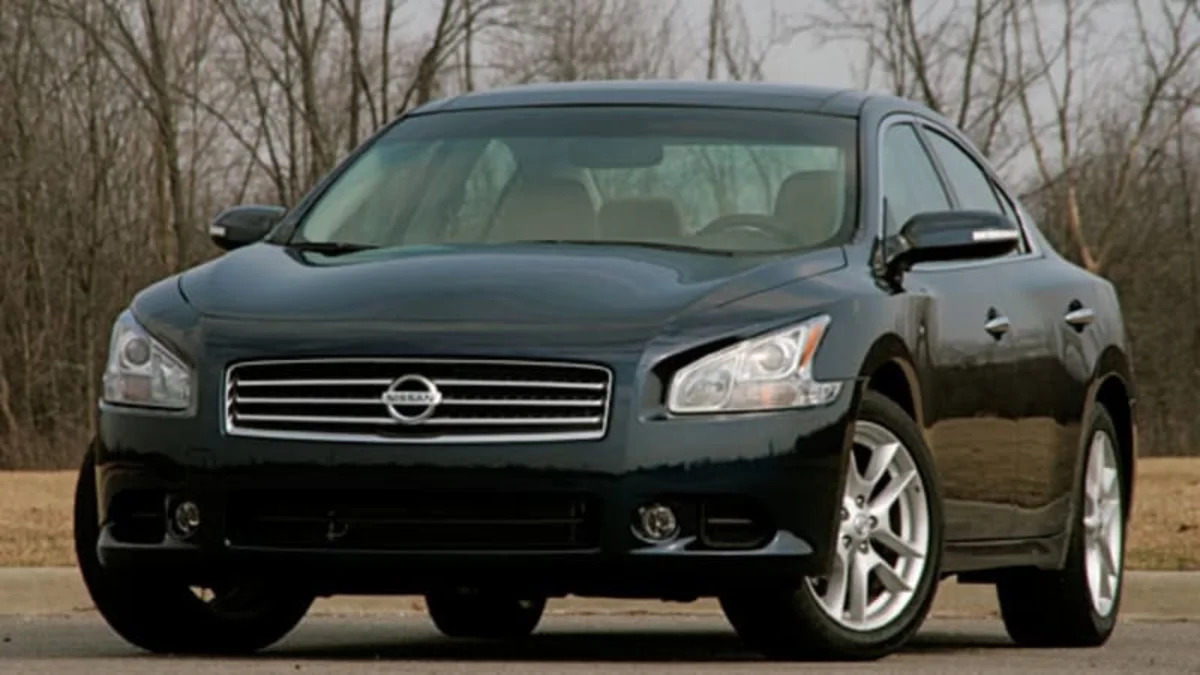
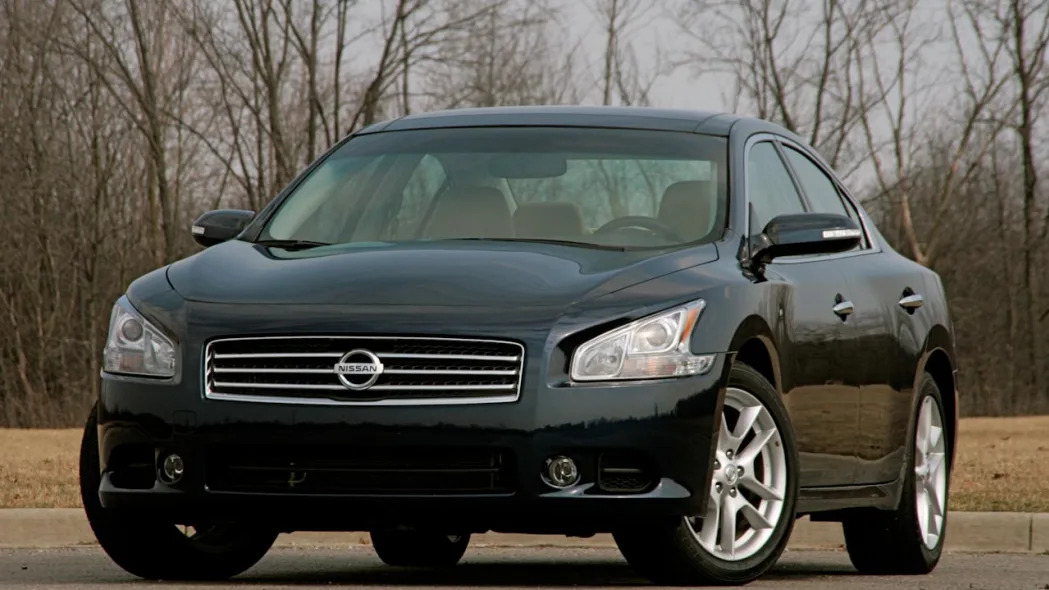

Sign in to post
Please sign in to leave a comment.
Continue